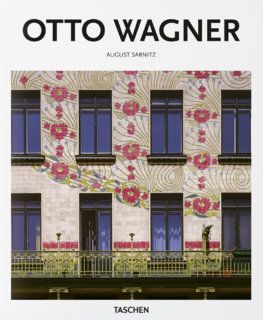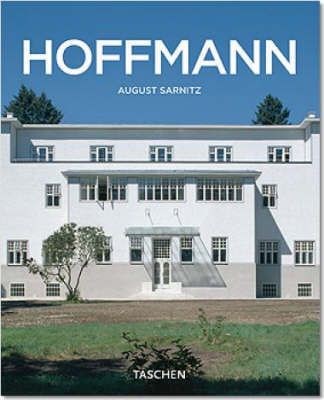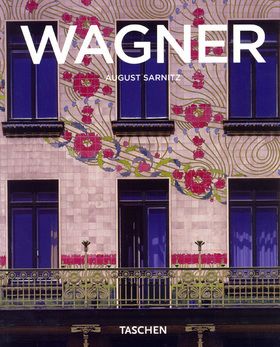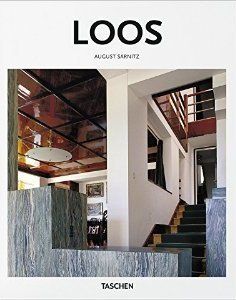August Sarnitz
autor
Otto Wagner
Kniha z populárnej edície predstavuje priekopníka modernej architektúry evolucionára Otta Wagnera. Známy architekt prispel používaním nových výrobných techník a stavebných postupov k prekonaniu historizmu a nástupu moderny.
Hoffmann Kc
The influence of the Austrian architect and designer Josef Hoffmann (1870-1956) is extraordinary: for a period of over 60 years he kept up an aesthetic dialog with Modernism, the International Style, and Art Deco. Before being rediscovered in the 198
0s by the Post-Modernists, his work was nearly forgotten; now his importance is unquestioned. As a designer he was one of the leading proponents of the Wiener Werkstätte, with its close connection to the Arts and Crafts movement. As an architect, he
built the first modern buildings in Europe, such as the Purkersdorf Sanatorium (1904) and the Palais Stoclet (1905-1911). Traversing several styles and schools during his lifetime, his work shows a consistent Formalism. He abandoned Functionalism lon
g before it became obsolete. In a historic sense, Hoffmann was doubly avant-garde: in both the rise and fall of Modernism.
Vypredané
9,42 €
9,92 €
Wagner (mini Taschen)
Kniha z populárnej edície predstavuje priekopníka modernej architektúry evolucionára Otta Wagnera. Známy architekt prispel používaním nových výrobných techník a stavebných postupov k prekonaniu historizmu a nástupu moderny.
Vypredané
4,70 €
4,95 €
Hoffmann
Rakouský architekt a designér Josef Hoffmann (1870-1956) dalekosáhle ovlivnil svou dobu: celých 60 let vedl tvůrčí dialog se secesí a stylem art deco. Předtím, než ho v osmdesátých letech znovu objevili postmodernisté, upadlo jeho dílo téměř do zapomnění; nyní je jeho význam nepochybný. Jako designér byl jednou z klíčových osobností Wiener Werkstätte a udržoval úzké styky s hnutím Umění a řemesla. Jako architekt dal Evropě některé z jejích prvních moderních budov, například sanatorium v Purkersdorfu (1904) nebo Palais Stoclet (1905-1911). Ve svém díle kráčel napříč různými styly a školami, ale zachovával neúchylný formalismus. S funkcionalismem se rozešel ještě dříve, než tento styl vyšel z módy. Z pohledu dějin byl Hoffmann dvakrát avantgardní: při vzestupu modernismu i při jeho pádu
Vypredané
4,70 €
4,95 €
Loos
Adolf Loos, ktorý na prelome storočia svojou kritikou súčasnej kultúry „literárne“ zbúral zastaralé stavby historizmu, by dnes asi dostal titul guru lifestylu. Jeho životný štýl, slobodný a prijímajúci podnety z celého sveta šokoval bigotnú viedenskú spoločnosť tej doby.
Vypredané
8,48 €
8,93 €
Adolf Loos
The devil in the details: The life and times of Adolf LoosAdolf Loos (1870 1933) was a flamboyant character, whose presence in the cultural hotbed of early 1900s Vienna galvanized the country s architectural landscape. An early, impassioned advocate of modernism, he all-out rejected the grand Secessionist aesthetic prevalent in contemporary Viennese architecture, as well as any hallmarks of the European fin de siecle.Instead, in lectures and essays, such as the milestone Ornament and Crime of 1913, Loos articulated his passion for smooth and precious surfaces. He advocated that architectural ornamentation was, by its nature, ephemeral locked into current trends and styles, and therefore, quickly dated. In doing so, it would drag the building it decorated, into obsolescence. Loos, himself a Classicist at heart, argued instead for simple, timeless designs with time-honored aesthetic and structural qualities.Rising to prominence in Vienna in the 1890s with commercial retail projects in the city, Loos developed his signature style, introducing the concept of spatial plan architecture and eschewing decorative fripperies for opulent, fine-quality materials, rendered in crisp lines. Major projects, such as Vienna s Cafe Museum (1899), Loos House (1912), and the fashion store Knize (1913), divided critics, the public, and even royalty Emperor Franz Joseph I would refuse to travel past Loos House, bristling with rage at its insolently minimalist aesthetic.In this introduction to Adolf Loos colorful and inspiring career, we get to explore the writings, achievements, and legacy which continued to resound down the decades, influencing successive styles and generations in the architectural conversation between elaborate and elemental aesthetics."
Hoffmann
The life aesthetic Josef Hoffmann s pioneering minimalism Before aesthete, designer, and architect Josef Hoffmann (1870 1956) came along, Austrian architecture and design was suffocating under a surfeit of opulent ornamentation and bombastic flourish. With his radical new approach and a band of like-minded figures, Hoffmann was a founding father of the Viennese Secession and Wiener Werkstatte, and revolutionized Western aesthetics with a brave new minimalism. A trained architect, Hoffmann lived his life as an extreme aesthete, while also cultivating his image as a bon viveur, a lover of women, a snappy dresser, and a provocative thinker. Gifted with a questing intellect, he continually challenged received orthodoxies and pushed for purer design in buildings and furniture, glass and metalwork. Joining forces with Joseph Maria Olbrich, Gustav Klimt, and Koloman Moser, he founded the Vienna Secession in 1897, and later established the prestigious production community of the Wiener Werkstatte, with its close connection to the Arts and Crafts movement. Over his 60-year career, Hoffmann s radical approach saw the creation of some of Europe s first major modernist buildings, such as the Purkersdorf Sanatorium (1904) and the Palais Stoclet (1905 1911), replete with Klimt murals. Many of his homeware designs remain in production to this day. This essential introduction explores Hoffmann s key ideas, buildings, and designs to examine an essential modernist who continues to directly inform and inspire European aesthetics, from monochrome interior schemes to the cutlery we set on the table."
Vypredané
15,68 €
16,50 €
Arch, Wagner
Otto Wagner (1841–1918) is one of the most significant figures of turn-of-the-century architecture. He was associated with the Viennese Secession, a group of artists and designers headed by Gustav Klimt that initiated a departure from the conservative style of the Viennese Künstlerhaus. Wagner’s visionary approach, described as structural rationalism, pioneered the use of materials such as glass, steel, and especially aluminum to redefine Viennese structural identity.
From the imposing Austrian Postal Savings Bank to the scintillating St. Leopold Church at Steinhof, one of the most important Art Nouveau churches in the world: Discover the breadth of Wagner’s career as well as the political, economic, and social dynamics of his time. This incisive overview features a map locating all of the architect’s most renowned projects and recent, fresh photography from masters like Keiichi Tahara.
Vypredané
15,68 €
16,50 €
Lacná kniha Arch, Wagner (-70%)
Otto Wagner (1841–1918) is one of the most significant figures of turn-of-the-century architecture. He was associated with the Viennese Secession, a group of artists and designers headed by Gustav Klimt that initiated a departure from the conservative style of the Viennese Künstlerhaus. Wagner’s visionary approach, described as structural rationalism, pioneered the use of materials such as glass, steel, and especially aluminum to redefine Viennese structural identity.
From the imposing Austrian Postal Savings Bank to the scintillating St. Leopold Church at Steinhof, one of the most important Art Nouveau churches in the world: Discover the breadth of Wagner’s career as well as the political, economic, and social dynamics of his time. This incisive overview features a map locating all of the architect’s most renowned projects and recent, fresh photography from masters like Keiichi Tahara.
Vypredané
4,95 €
16,50 €
dostupné aj ako:












